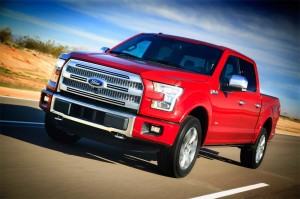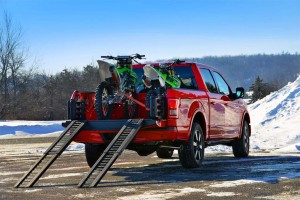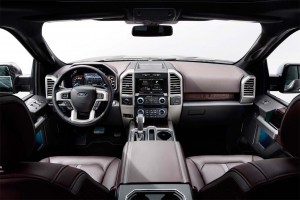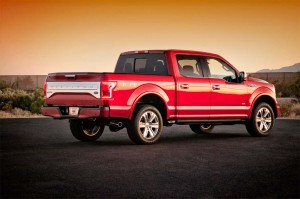
While the new F-150 may look as if it received only a touch up for this year, it's the extensive use of aluminum that's the real improvement.
The all-new F-150 making its debut at the North American International Auto Show in Detroit this week might initially look like little more than an evolutionary step forward for the best-selling pickup. But with its shift from steel to aluminum Ford hopes to rewrite the rules in the tough-truck segment. It’s a move that could send competitors scrambling – but also risks leaving skeptical buyers sitting on the sidelines.
Only a few years ago, skeptics began to wonder whether the once-massive full-size pickup market might be dwindling into insignificance. Indeed, during the depths of the recession, sales dipped to a mere 1.1 million, barely half the segment’s previous annual peak. But with the U.S. economy finally building momentum, the housing market, in particular, showing signs of life, pickup sales soared in 2013, to a solid 1.9 million.
Leading the charge was the Ford F-Series, which accounted for sales of 763,402 trucks last year, about 283,000 ahead of its nearest competitor, the Chevrolet Silverado. That cemented the F-Series’ hold on the market as not only the best-selling truck in America for 37 consecutive years but also as the best-selling vehicle overall for 32.
So, why is Ford about to take what could be one of the biggest risks it has made in decades with the heart-of-the-market version of its full-size truck, the F-150? Because, goes the old argument, no risk is the biggest risk as all. And with the F-Series facing an award-winning Ram 1500 from Chrysler and two new offerings from General Motors – and with both Toyota and Nissan promising to get even more competitive in the truck segment – Ford wanted to set the new benchmark rather than worry about meeting targets other manufacturers might hope to set.
The reality is that Ford isn’t the first maker to migrate to aluminum. The lightweight metal has been gaining increasing usage across the auto industry. Audi and Jaguar rely on aluminum for many of their latest models and even the old Ford F-Series had some aluminum body panels. But the 2015 F-150’s body is made almost entirely of the lightweight metal – with the exception of a “quiet steel” dash panel.
And while the new truck’s chassis is still largely steel-based – in fact, shifting to 70% ultra-high strength alloys – it also adopts aluminum for key components, such as its suspension.
The impact is substantial. On the whole, the new 2015 Ford F-150 weighs in at anywhere from 500 to more than 700 pounds lighter, depending on model, than the most recent version of the truck, said Pete Reyes, the program’s chief engineer. And while the maker isn’t ready to release fuel economy figures, the general industry rule of thumb is that each 100 pounds of mass a vehicle sheds translates into about one mile per gallon better fuel economy.
In today’s market, even with fuel prices down sharply from last year’s peaks, that alone could prove a game-changer. But Reyes and other Ford officials say new F-150’s aluminum-intensive design has other advantages. Forget the image of easily crushed beer cans, the chief engineer emphasizes. The unique aluminum alloys used in the 2015 truck are actually more ding- and dent-resistant than conventional steel.

While aluminum may be the big news, the 2015 F-150 gets a slew of new amenities, such as ramps that tuck into the bed of the truck.
By “lightweighting” the truck, Reyes says Ford can deliver other benefits. Make the vehicle itself lighter and you gain “the ability to invest that into pulling more load and hauling more load,” he explained.
“This is the ‘and’ solution,” suggested Ford Truck Group Marketing Manager Doug Scott, a reference to the automaker’s current ad campaign which argues that buyers want more, not more trade-offs, for their money.
Days before the new truck received its high profile unveiling at Detroit’s Cobo Center, Ford invited a handful of journalists to check out the 2015 F-150, a high-end Platinum edition. A casual viewer might not realize just how dramatically it has changed – in part because the more revolutionary revisions aren’t easily seen. But a closer look also shows that the new model has received some welcome design updates, as well.
“We spent a lot of time in the wind tunnel,” noted Gordon Platto, the chief designer, adding that fuel-saving aerodynamics had a significant impact, though the goal was to maintain familiar “heritage cues.” The front air dam was lowered and a new spoiler was added to the top of the tailgate. The windshield is more steeply raked. And the 2015 Ford F-150 also has active shutters hidden behind the grille to reduce wind drag when the engine cooling needs are low.
Recognizing this is as much a “lifestyle vehicle (as) a work truck,” according to Platto, the new pickup adds a number of other features. There’s a remote release available for the tailgate, for example, the tailgate also offering fold-out steps. The cargo bed has been completely redesigned and adds new storage and tie-down options. It will even be offered with stowaway ramps that can be used, for example, to roll a motorcycle into the bed.

The interior of the 2015 Ford F-150 boasts an eight-inch touch screen display allowing for easy access to Ford's infotainment system.
(Ford’s Farley apologies for spying flap. For more, Click Here.)
The cabin features a number of high-tech touches, including the latest in Ford’s Sync-based infotainment technology, starting with a larger touchscreen, as well as a new eight-inch reconfigurable LCD screen for the gauge cluster. The new F-150 will offer a new 360-view monitor so a driver can see what’s around the big rig, as well. Among other options are spotlights built into the moveable side mirrors that can be used at a work or campsite.
As for powertrains, Ford will drop the F-Series’ big 6.2-liter V-8 but is adding a second turbocharged EcoBoost powertrain, this one displacing 2.7-liters and capable of handling up to an 8,000-pound tow load. A second EcoBoost engine, at 3.5-liters, will now be the most powerful powertrain package, with F-150 buyers also able to choose a 5.0-liter V-8 or a naturally aspirated 3.7-liter V-6.
(Click Here for more about Mulally’s plans to stay at Ford.)
“Fuel economy will be better across the board,” promised marketing chief Scott.
While the members of the F-150 project team insist potential buyers should be comfortable with the switch to aluminum, the automaker isn’t taking chances. It will emphasize the benefits of the lightweight metal at its Detroit Auto Show stand and at other events this coming year. And it is working with dealer and independent service shops around the country to ensure they’re equipped to work with the new design when service or repairs are needed.
Making big changes in a conservative market segment is also risky, industry analysts caution. But if the new approach works, they add, Ford could get an even firmer lock on the full-size pickup market.

